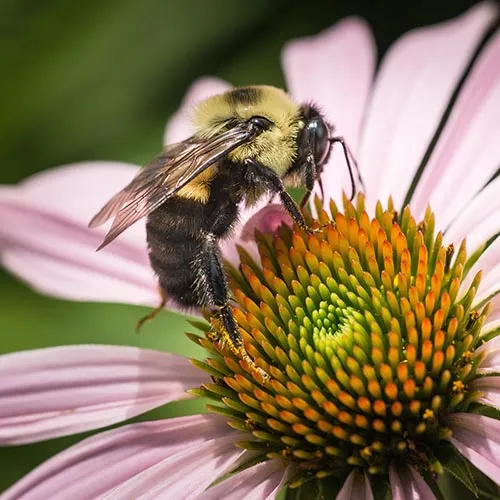When people go to the grocery store, they often carry two ideals with them to guide their choices. One is to look for things at a good price. If a desirable item is on sale, then perhaps we should buy it, or even buy two of them. Maybe more, and put some away for later? Alternatively, we may look for something that complements what we already have at home. If we already have a chicken at home, then buying another one is not as good as buying broccoli and potatoes. It turns out bees do the same thing when foraging at flowers, and the results are very positive ecologically.

A bumble bee on a cone flower.
The bees we see in our backyard represent both the honey bees (Apis mellifera) that were introduced to North America as domesticated farm animals, and the native bees that have always been here, by the hundreds of species. Pretty much everyone has recognized a native bumble bee at one time or another, and there are others that are less obvious. Some readers of this blog will know sweat bees, often small and metallic green, that live alone and provision their few larvae in a burrow they dig in the soil. What our native bees have in common is that they are shoppers who seek balance in the food they bring home.

Pollen is not the same across all flowers. Some pollen is high in protein, which provides the critical amino acids, the building blocks of life. Others are rich in lipids, the fats and oils that are prime sources of stored energy. When a native bee goes to a flower and collects pollen high in protein and low in lipids, the next time out she favors pollen of a different flower that is higher in lipids and lower in protein, to create a more balanced profile than if she collected the same thing over and over. Most native bees create a pollen ball, one at a time, to serve as the entire food source for a single larva, so a balanced diet must be created every day. Each female bee creates a balanced meal for each little larva: a little of this, some of that, a bit of this other thing. They look for balance.

By contrast to wild bees, honey bees send forth an organized team of foragers to bring back as much food as possible for the thousands of adult bees and thousands of larvae lodged in the honey comb. If a scout finds a very good resource, perhaps a field of a certain flower in bloom, or a large tree covered in flowers, then she communicates where that resource is by displaying the honey bee dance. Soon, her sisters fly out to find that field of flowers or that tree, and collect more pollen to bring home. It is as if the scout says “The discount store has ramen noodles on sale!” and they buy 1000 boxes. Honey bees are shopping for bargains. This is successful because next week a different product will be on sale in a different field or tree, and the bees will collect that. The colony as a whole can balance nutrition even if it is not balanced day by day.

What is the ecological effect of this? Why don’t honey bees simply eat the native bees out of house and home? Despite plenty of investigation into potential bad effects of honey bees on native bees, there is very little evidence that wild bees suffer under the ordinary densities that honey bees have on the landscape. Some of this is because the honey bees are looking for the giant, blowout sale: It is unlikely that even their army will strip clean an entire field or tree such that the solitary foragers of the native species have nothing left of that super-abundant resource. Further, as the years pass, because having honey bees in the ecosystem pollinates so many more plants, there will be more flowering plants to harvest than if honey bees were not there. This is certainly a benefit the solitary wild bees enjoy.

Native bees go to the boutique delicatessen and honey bees go to the discount store. Because they have different paradigms, they can coexist on the landscape even if they look like competitors.

